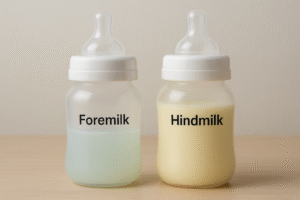If you’ve ever noticed your breast milk looking thin or bluish, you might have wondered — is my milk too watery? The truth is, breast milk naturally varies in fat content, and the “fattier” hindmilk plays a big role in your baby’s growth and satiety. This guide will help you understand what affects milk fat levels and show you how to produce fattier, creamier breast milk — safely and naturally.
1. Understanding Foremilk vs. Hindmilk
Your milk changes during each feeding session:
- Foremilk (the milk expressed at the start) is thinner, higher in water and lactose, keeping your baby hydrated.
- Hindmilk (the milk at the end) is thicker and richer in fat — helping your baby gain healthy weight.
The goal is to ensure your baby gets enough hindmilk at each session, which depends on your feeding or pumping habits.
2. Why Breast Milk Sometimes Looks Thin or Blue
Blue or clear milk doesn’t mean poor quality — it just has less visible fat. This usually happens if:
- You switch breasts too quickly.
- Pumping sessions are short.
- You have oversupply, causing more foremilk release.
➡️ For more on this, read our related article: Why Is My Breast Milk Blue?
3. Causes of Low-Fat Milk Production
Several everyday habits can influence fat concentration in your milk:
- Short or infrequent pumping sessions
- Not fully emptying one breast before switching
- Skipping nighttime feeds or pumps
- Stress and dehydration
💡 Hormonal Link:
Late-night milk (especially between 3–4 AM) naturally contains higher fat levels. This happens because prolactin and progesterone — the key milk-producing hormones — peak during these hours. So, missing nighttime feeds may slightly reduce the overall fat balance in your milk.
Good news — small adjustments can make a big difference in milk quality!
4. How to Produce Fatty Breast Milk Naturally
🍼 Pump or Nurse Longer from Each Breast
Always allow at least 15–20 minutes per breast to ensure you reach the richer hindmilk layer. Finishing one side completely helps your baby receive the balanced nutrition they need.
💆 Gentle Breast Massage

Massage your breast before and during pumping or feeding to help release trapped fat globules and improve milk flow.
🔁 Use the “Finish One Side First” Technique
Avoid switching breasts too early. Let your baby stay on one breast until it feels soft or light.
🥑 Eat Healthy Fats

Include omega-3 rich foods such as avocado, nuts, flaxseed, olive oil, and fatty fish. These healthy fats enrich your milk’s quality.
💧 Stay Hydrated
Water directly affects milk production. Aim for 2–3 liters daily, especially when feeding frequently.
😌 Manage Stress
High stress can interfere with milk let-down. Try deep breathing, warm compresses, or listening to calming music while feeding.
5. How to Store Fatty Milk Properly
When storing expressed milk, fat tends to rise and separate. Before feeding, gently swirl (not shake) to mix the layers again.
💡 Storage Connection:
Fat separates quickly in stored milk. Always gently swirl stored milk to recombine the fat layers before feeding, ensuring your baby gets those essential fats.
Learn the safe storage method in our guide: How to Store Breast Milk Safely.
6. Myths About Fatty Milk
- ❌ “Thin milk means bad milk.” → Not true. Foremilk is essential too.
- ❌ “Eating junk food makes milk fattier.” → Wrong! Only healthy fats support quality milk.
- ✅ Balanced feeding and proper pumping time are what truly increase fat concentration.
7. FAQs
Q1. How can I tell if my breast milk is fatty enough?
You’ll notice a creamy layer forming at the top after refrigeration — that’s the fat!
Q2. Does diet really change milk fat?
Yes, healthy fats (like nuts and olive oil) can enhance your milk’s richness.
Q3. Should I pump after every feeding to increase fat?
If you have oversupply, avoid over-pumping. Just make sure each breast is emptied fully.
Q4. How long should I pump per breast?
Aim for 15–20 minutes or until milk flow slows significantly.
8. Recommended External Resources
Conclusion
Producing fatty breast milk isn’t about changing your body — it’s about understanding how milk works and adjusting your feeding pattern accordingly. With consistent sessions, proper emptying, and a nutrient-rich diet, your milk will naturally balance both hydration and fat.
Remember: Your milk — whether thin or creamy — is uniquely designed for your baby. Focus on regular feeding, care, and rest, and your milk will provide everything your little one needs. 💛











